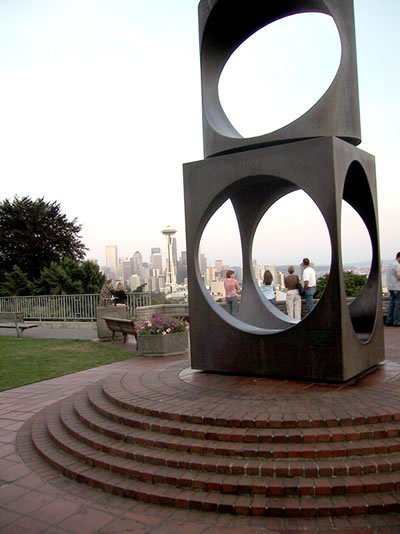"United South Slope Residents" Save Kerry Park
The three blocks of West Highland Drive between Third Avenue West and Queen Anne Avenue North are among the most important tourist attractions in the city.
Anchored by Kerry Park with its fantastic views of the Space Needle, downtown, Elliott Bay and –- on many a glorious day –- Mount Rainier, this neighborhood has had a most contentious history. Its residents have always valued its beautiful vistas, and on many occasions over the last century, have come together to work to block unattractive developments that would obstruct the views or destroy the street’s historic character.
At the turn of the 20th century, anticipating a battle, neighbors on West Highland Drive purchased the block between First and Second Avenues West to prevent construction of an unidentified project they did not want; this site later became the Victoria Apartments.
A couple of decades later, neighbors throughout the area contributed to the purchase of the lot across the street to protect it from development.
The lot was donated to the city in 1927 and is named for the Albert S. Kerry family, which contributed $20,000 toward its purchase. In 1971, in their father’s name, Kerry’s children also donated to the City the space frame steel sculpture “Changing Form” by Seattle artist Doris Chase.
A plaque on the wall states:“Kerry Park given to the City in 1927 by Mr. and Mrs. Albert Sperry Kerry, Sr., so that all who stop here may enjoy this view.”
According to Mimi Sheridan’s discussion of the history of Queen Anne apartment buildings, the construction of the Victoria Apartments in 1921 kicked off the 1920's building boom – to some degree. Its architect, John Graham, Sr., designer of many of the city’s most important commercial buildings (The Bon, Frederick & Nelson, the Ford Plant at Lake Union), ceremoniously announced the Victoria’s start in May 1921, saying that the “mammoth community apartment house” indicated a “fast reviving building situation in Seattle.”
In the 1970’s, a group of Queen Anne citizens formed United South Slope Residents, or U.S.S.R., to fight high-rise development on the south side of the hill. Alarmed by the construction of the tall building at 111 W. Highland Dr. that blocked the views from the Victoria and by a proposal to build a very tall building on West Comstock adjacent to the Victoria, citizens led by architect Art Skolnik -- who served as the first head of both the City and the State’s offices of historic preservation -- and other historic preservation advocates solicited 4,800 signatures on a petition insisting on low-rise development.
The City Council responded to the uproar by modifying the zoning regulations for the south slope of the hill. Subsequently several developers filed hasty building permits to grandfather their rights under the old code. Challenging those developers who had sued the City to protect their permits, U.S.S.R. organized house tours and raised money to hire well-known and respected Seattle land use attorneys Thomas Goeltz, Susan Agid and Jerry Hillis who continued the fight in court on behalf of U.S.S.R.
As a result of their eventual victory in court, environmental reviews required by the State Environmental Policy Act must now evaluate the cumulative negative environmental impacts of projects rather than a narrow look at the impact of each development on its immediate surroundings. What began as an effort to protect Queen Anne’s south slope had far-reaching impacts across the state.
Across the street, on the south side of Highland Drive, lie two historic apartment houses, the 1926 Narada Apartments (55 West Highland Drive) and the 17,046 square-foot Harry Whitney Treat House (13 West Highland Drive). Architects Charles Bebb and Louis Mendel adopted a half-timbered style for the 64-room Treat House. At the time of its construction in 1905, it was by far the largest home on the hill. The porch and the south side were originally open, and the lowest floor had a ballroom, men’s gambling room and a stage.
In 2006, the owners put the Treat house on the market with the expectation that it would be demolished. Learning of the potential sale, the Queen Anne Historical Society immediately committed to its preservation, and took steps to support its designation as a City landmark. Society members understood that the building had been compromised inside and out by the conversion to 15 apartments and the overlay of a brick veneer on the exterior. In fact, the owners of the house initiated the nomination process in the hope that it would be denied, leaving them or a succeeding owner free to tear it down to build a high-rise apartment building in its place.
The battle to preserve the Treat House pitted the Society against Art Skolnik, hired as the building owner’s advocate. Skolnik, the very same man who championed the cause of U.S.S.R. in the 1970’s, argued that Harry Treat was a bit of rogue whose house shouldn’t be honored by landmark designation. The Society took the position that the building’s critical transitional value on the most important street corner in the neighborhood merited its designation. This time the Society prevailed, and the Treat House is now a permanently protected City landmark.
Few streets share the raucous history of West Highland Drive, but few places have such phenomenal views and such a valuable collection of historic buildings worth preserving. The stories of the battles to save this site and its fabric are important parts of Queen Anne history and worth preserving in their own right.



